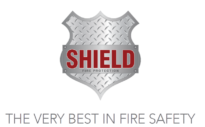FAQs
How do I clean up dry chemical after a fire?
Clean-up of the product is best achieved using a vacuum or wet sweep and shovel. Either method will minimize the generation of dust. Bag or drum the product for disposal. If the product has been used on a fire or has become contaminated, use personal protective equipment and containment means that are appropriate for the composition of the mixture.
How do I dispose of dry chemical?
Shield dry chemical extinguishing agents are not characteristically hazardous or listed as hazardous waste. Dispose of in accordance with state or local laws, which may be more restrictive than federal regulations. Keep in mind that if the product was used on a fire the characteristics of the waste mixture may have been altered or contaminated. Disposal of this waste may require different disposal considerations. As each situations may be different, Shield suggests consulting the appropriate regulatory agency for guidance on disposal.
Where do I find the year of manufacture on a portable extinguisher?
The year of manufacture is stamped into the bottom of the extinguisher cylinders. On the bottom, you will see three letters with two numbers underneath. The two numbers are the last two lights of the year of manufacture. For example, if the number 15 is stamped on the cylinder bottom, that indicates the year of manufacture as 2015. 09 would indicate 2009, 99 would indicate 1999, etc.
Are the fasteners for the extinguisher mounting hardware included with the unit?
No. The type of fastener used for mounting the extinguisher is dependent on the surfacer to which it will be mounted. The Owner's Manual included with every hand-held portable extinguishers has mounting instructions and the recommended type of fastener to be used for various surfaces.
Where do I find the Inspection Record that must be attached to each extinguisher?
The Inspection Record is found on the Owner's Manual that is included in the box of every portable fire extinguisher. The Record is cut off the Manual and attached to the extinguisher.
How does temperature affect the pressure reading of a stored pressure fire extinguisher?
As the extreme temperature months of summer and winter come upon us, Shield receives a number of questions about "leakers", or over-pressurized extinguishers. Users will see that the pressure gauge indicator is not pointing straight up, that it is positioned in the low or high side of the green pie-shaped "charged zone". In most cases, it turns out that the extinguisher has been subjected to extremes in cold or heat during transit, storage or mounting location.
In the manufacturing process, extinguishers are filled with extinguishing agent and pressurized with expellant gas at an ambient temperature of 68-70ºF. The pressure gauge on the extinguisher is calibrated to show the normal charged pressure at this temperature and the pressure indicator on the gauge will be pointing straight up. As the extinguisher is exposed to extremes in temperature (hot or cold), the expellant gas will expand or contract accordingly.
This will cause the pressure indicator to move left or right of center. As a visual aid, the green pie-shaped area on the gauge is intended to show a charged condition for the extinguisher through the temperature range for which the extinguisher is rated. For example, a dry chemical fire extinguisher has a operable temperature range of -65º to +120ºF. An extinguisher that is subjected to temperature ranges between -65º and +70ºF will have the pressure indicator register between the left edge of the green pie and the upright middle position.
Conversely, extinguishers exposed to temperature ranges of 70º to 120ºF will have the pressure indicator register between the upright position and the far right edge of the green area. In either case, if the pressure indicator is within the green "charged" zone, the extinguisher will operate as intended.
Are Shield fire extinguishers certified to NFPA or OSHA Standards?
OSHA Standards, NFPA Standards and local codes are Standards and codes that deal with the selection, installation, inspection and maintenance of fire extinguishers. All of those issues are under the control of the party that purchases the fire extinguisher. As manufacturers, we cannot control what happens to the extinguishers once they leave our factory.
It would be misleading for Shield to state that our extinguishers comply with those Standards or codes. What we can say is that the extinguishers have been tested and Listed by UL, as meeting the construction and performance Standards appropriate for that model of extinguisher (e.g. UL 299 and UL 711 for dry chemical fire extinguishers) and wherever local codes or a Standard such a NFPA 10 or OSHA requires UL Listed extinguisher, Shield fire extinguishers can be used to fulfill that requirement.
Can I get a Coast Guard Certificate of Compliance for Shield fire extinguishers?
The Coast Guard does not conduct approval review of portable fire extinguishers. The regulations require that extinguishers are tested, listed and labeled by a Coast Guard recognized Independent Testing Laboratory. Currently, Underwriters Laboratories, Inc. (UL) and Underwriters Laboratories of Canada (ULC) are Recognized Independent Laboratories.
Essentially, UL and ULC administer the Coast Guard's extinguisher approval program on the Coast Guard's behalf with Coast Guard oversight. Therefore, the Coast Guard does not issue certificates of approval for portable fire extinguishers. Instead, an approved extinguisher can be identified by the marine type label, such as "Marine Type, USCG approved, Type X, Size X, USCG approval number 162.028/XX." Shield's USCG approved extinguishers are listed in the UL online Certification directory.
